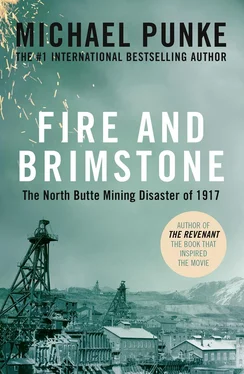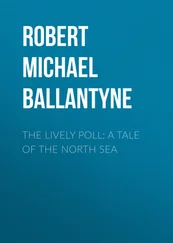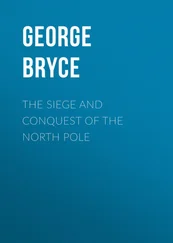Silver would bring Butte back to life. And with silver would come critical components of the later copper industry: capital, technology, and a stout Irishman who would soon lock horns with William Clark in one of the most dramatic feuds in American history.
Marcus Daly was born in 1841 in Ballyjamesduff, County Cavan, Ireland. Like his enemy William Clark—in fact, to an even greater degree—Daly’s life story reads like a Horatio Alger tale. As a child, his family endured the hardships of the potato famine, and young Marcus watched his countrymen abandon the Emerald Isle by the drove. 15
At the age of fifteen, Marcus emigrated—alone and penniless—to New York City. In New York he worked for five years in a variety of jobs, including errand boy at a commission house, hostler in a livery stable, telegraph operator, and finally as a longshoreman on the Brooklyn docks. Perhaps through his connections on the docks, Daly in 1861 managed to gain passage on a ship to Panama. From there, he traversed the malarial isthmus and then continued by land up the coast to San Francisco.
In California he worked for a time on ranches and farms but soon followed a friend into mining. For a while he tried his hand at placers, eventually gravitating toward work in established mines. By 1862, Daly landed at Nevada’s mighty Comstock—the greatest silver mine in history and the largest, most sophisticated operation of its day.
It was at the Comstock that Daly truly learned the trade of mining: how to recognize fruitful veins; how to tunnel; how to timber; how to blast. His growing talent was rewarded with promotion to shift boss, and Daly would add to his skills the intangible quality of leadership. Throughout his career—in sharp contrast with his rival William Clark—Daly would be known as a miner’s miner, a benevolent dictator beloved by his men. 16
It was during his time in Nevada that Daly also forged important relationships—from his reporter friend Samuel Clemens (not yet writing under his later pen name of Mark Twain) to George Hearst, his eventual financier and partner. The West of the 1860s was a dynamic, booming place. Potential for a talented young man seemed boundless, and Daly made the most of every opportunity.
By the time Daly left the Comstock in 1868, he was widely recognized as one of the West’s leading young miners. A new opportunity presented itself in 1870, when Daly’s reputation drew the interest of the Walker brothers—four powerful merchant-bankers out of Salt Lake City. The Walkers hired Daly to run their Emma silver mine, then their Ophir. Both properties boomed. Around this time, the Walkers began to catch wind of opportunities in a Montana town called Butte. In 1876, they sent Marcus Daly to scout it out.
Daly, known for being able to “see farther into the ground than any other man,” 17liked what he found. He settled on a recommendation that the Walker brothers purchase a silver mine called the Alice. The Walkers agreed, giving Daly an equity share to move to Butte and run the mine. The Alice—purchased for $25,000—would ultimately produce millions in silver for its owners. The mine would also launch Daly, and most significantly, signal the true takeoff of Butte’s silver boom. 18
Daly superintended the Alice for five years and in the process became a wealthy man. For Daly, though, the object was not wealth, but empire. In 1880, he sold his share in the Alice for “a rumored $100,000” and began searching Butte for another property. 19What he found would surpass his wildest dreams, for nothing like it had ever existed before.
In 1875, a former Union soldier named Michael Hickey staked a claim on the Butte Hill, hoping to catch the swelling wave of silver. As an infantryman in McClellan’s Army of the Potomac, Hickey had fought in Richmond and Petersburg. Before the battle for Richmond, he read a Horace Greeley editorial in the New York Tribune . “Grant will encircle Lee’s forces …” predicted Greeley, “… and crush them like a giant anaconda.” 20
The image of an “anaconda” would stick with Hickey, and when it came time to name his new claim, “That word struck me as a might good one.” 21In the five years following its establishment, the Anaconda was no better than a middling prospect in a town where scores of companies had staked their claims. But Marcus Daly turned the tide. According to Butte lore, Daly met Michael Hickey one day while taking a walk. Hickey told Daly about the progress at his mine. “I’ve sunk a forty-five-foot shaft on my Anaconda claim and I’ve sure got silver ore but I’ve got to go deeper to make it pay,” he said. “If you’ll deepen the shaft, we can make a deal.” 22
Daly would ultimately pay $30,000 for outright ownership of Hickey’s property. He had taken the first step toward his future empire, but it was only the first step. As Daly knew better than anyone, to transform the Anaconda into a profitable silver mine would require money. Money to sink and timber the shaft. Money to excavate the ore. Money to crush. Money to smelt. Money far beyond his own not insubstantial means. 23
There are conflicting stories as to why Daly did not stick with the Walker brothers of Salt Lake. By one account, he offered the Walkers an option on the Anaconda “but they could not be induced.” 24By another account “Daly froze them out.” Even as he ran the Alice for the Walkers, Daly corresponded with his old friends from the Comstock—George Hearst and the partners in his syndicate. In 1881, Daly traveled to San Francisco to present his plans. 25
George Hearst—father of the future newspaperman William Randolph Hearst—had reason to trust the ruddy Irishman from Butte. In his autobiography, the senior Hearst credited Daly with a tip to buy—for $30,000—a mine called the Ontario. The Ontario produced an estimated $14 million in silver and gold. “From that $30,000,” wrote Hearst, “everything else came.” 26
Hearst and his partners (including Lloyd Tevis, who would eventually preside over the Wells Fargo Bank) bought into Daly’s new Anaconda mine. Daly received 25 percent of the equity in the mine, management responsibility, and—most significantly—an almost limitless operating budget. 27In June 1881, workmen began sinking a new main shaft at the Anaconda. They quickly found rich deposits of silver. In the early days of the mine, ironically, Daly leased a mill from his future rival—William Clark. 28Clark, back from his study at the Columbia University School of Mines, was still frantically amassing his own early fortune.
The Anaconda was a profitable property on the basis of silver alone, but as Daly dug deeper, it was a less precious metal that would ultimately create a far greater treasure.
In late 1882, miners at the Anaconda were drilling at the 300-foot level when they began to encounter “new material.” Word was dispatched to Marcus Daly and his lieutenant Mike Carroll, who came down to look for themselves. They watched as dynamite was set in a circle of holes bored into the quartz walls. The fuses were lit and the men took cover. A great blast shook the mine.
When the debris settled, Daley stepped forward to pick up a chunk of the smoking rock. He turned to Mike Carroll excitedly. “Mike,” he said. “We’ve got it.” It was a singular moment, and it would change the life of both Daly and his adopted city of Butte. Marcus Daly had discovered the largest deposit of copper in the world. 29
Like many great men, Daly combined talent and hard work with good timing. At the Centennial Exposition in Philadelphia, just six years before Daly hit the Anaconda copper vein, a man named Alexander Graham Bell had demonstrated the transmission of speech through a copper wire. Two years before Daly’s discovery, a man named Thomas Edison received a patent for an invention he called the “incandescent lamp.” Through the inventions of Edison and Bell, the world was on the brink of an explosion in the demand for copper. 30
Читать дальше












